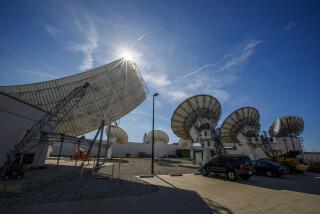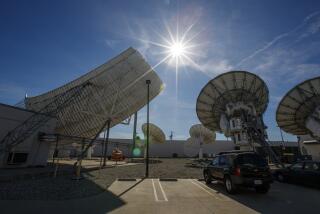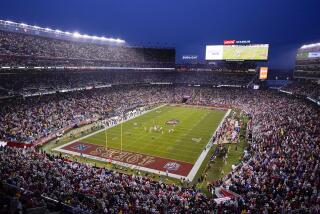Satellite TV on the Road Has Blind Spots
With satellite radio now widely available for cars, can satellite TV be far behind? After all, if we can watch satellite TV in the air on JetBlue, why not on the road?
It’s actually more complicated than it sounds.
But it is available, and the equipment to provide it -- including an antenna that looks like a giant Frisbee on top of a car -- has gotten so advanced that General Motors Corp. is promoting satellite TV as an accessory for the Cadillac Escalade SUV.
This year DirecTV Group Inc. started offering a channel package specifically for mobile use. And Cendant Corp.’s Avis Rent a Car System Inc. has begun a test program of offering rentals equipped with satellite TV.
Leaving aside for a moment the question of whether it’s necessary, or even a good idea, to get satellite TV in the car, there remains one big problem for this technological wonder: It doesn’t work very well in some areas.
Los Angeles, for example.
I drove an Escalade equipped with a satellite TV system made by KVH Industries Inc. to Van Nuys from Pasadena -- a distance of about 20 miles, mostly on freeways. My friend Tony Exter sat in the middle row of seats watching TV on three screens (two 7-inch screens in the headrests and a 9-inch screen that flipped down from the ceiling).
Tony made a pencil mark on paper for every time the TV image froze, pixilated or died completely. At the end of the trip, he had made 41 marks.
It wasn’t so bad given that he was watching (and I was listening to) a movie called “The Deep End of the Ocean” on the Lifetime channel that neither of us cared much about. But on the way back we were tuned to a stand-up routine by comic Judy Gold on the Logo channel. Then the glitches were more annoying -- nothing ruins comedy like sound gaps that wipe out the punch lines.
“I had the urge to hit the side of the screen, like you’d do to an old television,” Tony said.
The dropped signals occurred because satellite TV works strictly on a line-of-sight basis. Every time a building, overpass, sign or even a tree blocked the signal from the DirecTV satellite 22,000 miles out in space, there was a blip in the programming.
This, of course, is especially a problem in urban areas, where most people live in this country.
Satellite radio gets interrupted too but not nearly as often. That’s because of a basic technology difference between the two services.
Satellite radio, which debuted in 2001, was designed to be mobile. Its signals from space saturate a coverage area, making it easier to get reception even near obstacles.
But TV requires a more robust signal that needs to be focused to be effective.
“When you have video plus sound, you have to convey a lot more digital information,” explained Joseph Pelton, author of several books on satellite communications and a professor at George Washington University. “The satellite needs to send it to receiving antennas that are fixed to buildings and aimed directly at it.”
The Escalade’s antenna senses the direction of the signal and automatically rotates to line up its sensors with the beam. (When riding at slow speeds, you can hear the antenna, inside its enclosure, spinning to find the signal.) It even tilts to compensate for hills and didn’t seem to have trouble tracking the beam during sharp turns.
But a blockage of the low sky to the south, even for less than a second, causes an interruption.
(Airline satellite TV systems don’t have that problem because they operate far above blockages. Also, they can use much larger antennas, allowing them to catch a higher-quality signal.)
The car system worked much better when I got it out into open areas. I drove one night from Pasadena to Acton in the Antelope Valley, where there were long stretches with few interruptions. But even the overhead freeway signs caused some blips.
KVH has greatly improved the mobile system since it was introduced in 2003. (When I first saw it at a trade show, it could barely produce a watchable image.) But the line-of-sight problem remains.
“It could be a while before this would become a truly drive-around-downtown kind of system,” acknowledged KVH spokesman Chris Watson.
Satellite radio uses repeaters in some urban areas to help alleviate its blockage problems. But putting in repeaters for the denser television signals would be a far bigger project.
For the consumer, getting satellite TV in its present form is expensive. The price of the antenna and receiver package is about $2,300, plus installation that can run about $300 depending on the car. And if the car does not already have video screens (many SUVs have them for DVD use), those would have to be purchased and installed too.
Cadillac’s accessories manager, Doug Schumacker, said the price of the system would have to drop about $1,000 before it would become a manufacturer-installed option.
For now, the system can be installed by a car dealer or third-party audio/video merchant. (The Al & Ed’s Autosound and Good Guys chains are authorized installers in Southern California.)
By the way, it’s illegal in California and in many other states to have TV or a DVD showing on a screen that can be seen by the driver of a moving vehicle. I have no doubt this law is already being widely broken: The test Escalade loaned to us had a screen ostensibly for the front passenger, but I could easily see it from the driver’s seat. As if the L.A. freeways weren’t scary enough.
DirecTV’s mobile service, which costs $4.99 a month for current home subscribers or $41.99 a month for new subscribers, offers 111 TV channels. The only premium channel available is Starz movies.
A major drawback for sports fans is that local channels, the regional Fox Sports channels and sports premium packages are not available on the service. That leaves out almost all live Dodger and Angel games. The problem for satellite providers is that local and regional channels switch as the vehicle travels into different areas. A DirecTV spokesman said the company was working on ways to get the local and regional feeds onto the mobile menu.
So there you have it. You can have satellite TV in your car if you have excess cash and a lot of patience. And a large roof. The current KVH antenna is about 30 inches in diameter, which limits its installation to SUVs and the larger station wagons.
“We did hear of one guy who wanted it on his Corvette,” KVH’s Watson said. “We had to explain that would not be possible. And it’s disturbing: That’s not a car with back seats anyway.”
*
David Colker can be reached via e-mail at technopolis@latimes.com. Previous columns can be found at latimes.com/technopolis.
More to Read
Inside the business of entertainment
The Wide Shot brings you news, analysis and insights on everything from streaming wars to production — and what it all means for the future.
You may occasionally receive promotional content from the Los Angeles Times.











